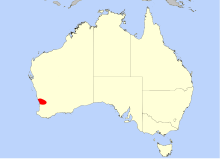Drosera helodes
| Drosera helodes | ||||||||||||
|---|---|---|---|---|---|---|---|---|---|---|---|---|

Drosera helodes , flower |
||||||||||||
| Systematics | ||||||||||||
|
||||||||||||
| Scientific name | ||||||||||||
| Drosera helodes | ||||||||||||
| NGMarchant & Lowrie |
Drosera helodes is a carnivorous plant in the genus sundew ( Drosera ). It belongs to the group of so-called dwarf sundews and is native to southwestern Australia.
description
Drosera helodes is a perennial herbaceous plant . This forms a crowded rosette-shaped bud of horizontal leaves with a diameter of about 1.3 cm. The stem axis is 2 mm long and covered with few or no withered leaves from the preseason.
The bud of the stipules is ovate, 7 mm long and 4 mm in diameter at the base. The stipules themselves are 3 mm long, 2.5 mm wide and three-lobed. The middle lobe is divided into 3 segments.
The leaf blades are approximately circular and up to 1.7 mm in diameter. The longer tentacle glands are on the edge, the shorter ones on the inside. The underside is hairless. The leaf stalks are up to 4 mm long, 0.5 mm wide at the base, 0.6 mm wide in the middle and isolated with only a few small glandular hairs near the leaf blade.
Flowering time is October to November. The one, and rarely two, flower stalks are up to 8 cm long and sparse at the base, and increasingly thickly covered with tiny hairs towards the tip. The inflorescence is a coil of 6 to 14 flowers on approximately 3 mm long pedicels. The broadly egg-shaped sepals are 2 mm long and 1.4 mm wide. The edges are notched and covered with red-headed glands. The light pink petals are inverted egg-shaped, 7 mm long and 3.5 mm wide.
The five stamens are 1.6 mm long. The threads and anthers are white and the pollen are yellow. The greenish-white ovary is broadly inverted ovoid, 0.6 mm long and 0.8 mm in diameter. The 3 greenish-white, horizontally extended stylus are 1 mm long under the scar and 0.5 mm above it. The scars are also greenish-white, curved upwards, 2 mm long and taper evenly to the tip.
The formation of brood scales is typical of dwarf sundews : The elliptical, 0.6 mm thick brood scales are formed in large numbers from late November to early December and are approx. 1 mm long and 0.7 mm wide.
The number of chromosomes is 2n = 18.
Distribution, habitat and status
Drosera helodes only occurs in a small area in the extreme southwest of Australia. The plant thrives there on sandy soils mixed with laterite in winter-damp depressions.
Systematics
The name helodes comes from the Greek and means "swamp" ("helos" = swamp), as it grows in relatively humid habitats.
literature
- Allen Lowrie : Carnivorous Plants of Australia. Volume 2. University of Western Australia Press, Nedlands 1989, ISBN 0-85564-300-5 , p. 62.
Individual evidence
- ^ Drosera helodes at Tropicos.org. In: IPCN Chromosome Reports . Missouri Botanical Garden, St. Louis
